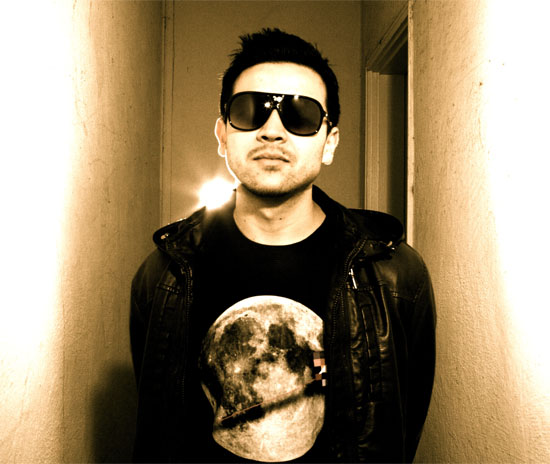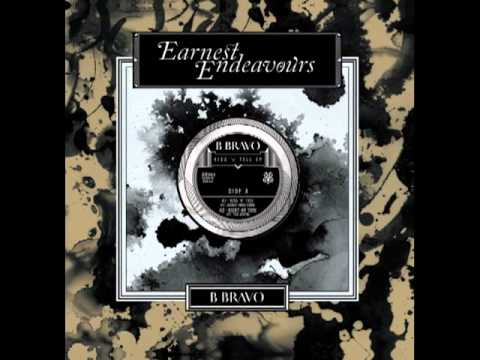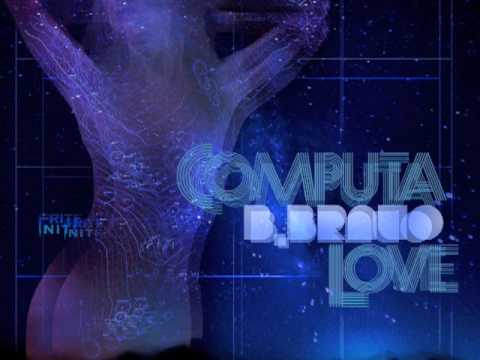B. Bravo is a San Francisco based producer putting the funk back in the West Coast – and he isn’t alone. Over the past five or so years that side of the States has fronted the movement of often dreamy, always skewed hip-hop known as beat music/the beat scene. I well remember people associated with the term resisting it with declarations like ‘There is no beat scene!’: labels or none, it happened. But, as with other populist forms, there comes a time when only a different approach can give a sense of things moving forwards – even when that ‘new’ angle is apparently retro.
On B. Bravo’s 2009 Analog Starship EP, released on San Francisco label Frite Nite, he infused the rhythmic style of beat music (and also just hip-hop that swings) with a funk idiom. Its basslines were distinctly groovy, and its synth melodies so expressive it’s like they were speaking – even when not made through a talk-box. By the time of Bravo’s 2010 Computa Love EP, the title a nod to the influence of Zapp & Roger’s groundbreaking talk box hit, he became more confidently funky: cosmic, exuberant top lines cascading over swaggering bass.
Last year Bravo released a third EP, Kiss ‘n’ Tell, through London based label Earnest Endeavours, after hooking up with them via the internet and his stay in London as a participant in Red Bull Music Academy 2010. Featuring vocals from the likes of Zackey Force Funk, The Gent$ and Lady Alma, Kiss ‘n’ Tell consolidated B. Bravo’s footing in the funkosphere.
Grouped with artists like DâM-Funk, Devonwho, and his own bandmate Teeko, B. Bravo could be thought of as part of a West Coast funk resurgence. As tends to be the case these days, any such movement has an international aspect, and a recent mix by Salva for The Fader placed him firmly in that context, alongside artists like Royalty, Arp101 and Greeen Linez. The point in grouping these producers as such isn’t simply to categorise or label, but to ask why we might want – or even need – something like this right now? Why might we want to regain something we have lost or forgotten? When DâM-Funk insists that he wants funk to become respected again – to be thought of not just in terms of silliness and Bootsy Collins’ platforms and glasses, but as a movement that brings together, as he put it, ‘the gangster and the classy’ – he references funk’s social history in terms of aspiration and actual elevation.
When we speak, B. Bravo and I agree that economic times like these call for funk. Tongue-in-cheek, I also coin the term ‘the West Cost Continuum’. Thinking this through after the interview, listening back through funky artists from James Brown to Cold 187um, and reading up on lowriding, it becomes clear that while what the likes of Bravo offer is definitely post G-funk – it’s in some of the sounds, the textures, the way the rhythms fall – they also drop the bravado in favour of fun, sex, and pleasure. Desire is back. Crucially, thanks to these artists’ constant reinterpretation of an aesthetic that’s always been important to them, they’re never purely retro – there is always forward momentum.
Bravo, real name Adam Mori, grew up in Monterey and has a history of playing saxophone in jazz bands. He started producing when he went to college in San Francisco, and found himself drawn to the ability to be in charge of every element of an arrangement. He is currently also in a band, The Starship Connection, in which he reinterprets B. Bravo compositions live with the help of Teeko, D-Nasty and Bob-O.
Does it add anything to the music, making it with other people?
Adam Mori: Absolutely, yeah. Just being able to open the songs up and let people jam, it’s never the same twice. These guys can play stuff I really want and add their little embellishments. It’s just a lot more energy, especially with the live show, we’ll all dance around and jump around.
So do you have an LP planned as well?
AM: Yeah, a solo LP for sometime next year. I’m still writing it. I’ve got a bunch of tracks.
Is it going to be along the lines of your first few releases?
AM: Yeah, I mean it will all have a similar sound, ‘cause I use a lot of the same equipment and stuff. It’ll be a logical progression, it’s not going to be the same, because I don’t want to keep making the same kind of stuff. But along the same lines, a lot of the same kind of influences. I’m going to try to branch out with some different styles and try to get a little experimental, because I think you can actually do that with a full LP – you can take your time and open things up. I’m really looking forward to that. I really want to do some abstract psychedelic stuff as well as what people expect.
What equipment do you use in the studio?
AM: MPC 2000XL for drums, Arp Odyssey, Juno 60, JP 8000, DX-7, Motif rack, MicroKorg. I use a PC with Nuendo software to do the recording, multracking, and mixing and for a couple of soft synths. I like to use the outboard gear ‘cause I like being able to feel the instruments and tweak the knobs and filters. I love the sound of the analog synths and the vintage boards, it just sounds organic and authentic to me. You can feel it when you play it. I like doing drums on the MPC too – I like the sound and its important for me to play the beats live to get the timing just right.
How do you keep yourself moving creatively? I mean, how do you make sure that you’re moving forwards?
AM: I guess I just try not to imitate anybody else, or I don’t try to redo anything I’ve already done. Like ‘Oh, let me make a song like this again’, or something. I just try to keep trying different things and take influences from other tracks and stuff, but never try to remake something. I always try to do something that’s new and fresh.
Where do you go out?
AM: Well there’s a new place just opened recently called Som, and the owner’s been really instrumental in the scene here, you know, just bringing in a lot of different groups, and he’s got good taste. So bringing in Electric Wire Hustle and all kinds of groups, all the stuff I like. […] He doesn’t do anything just for money, he just really tries to bring in good music. His name is Jacobo.
Is there like a ‘scene’, of people like you, in the Bay Area and LA, making kind of … funky hip hop?
AM: Well a little bit. My friend Teeko is from San Francisco as well, and that’s how we got together and started doing stuff. We both have really similar taste and we both love synthesisers and analogue gear, and we both have an ear for the same kind of music and chord progressions, a lot of soul and jazz kind of chords. So he’s definitely doing similar stuff, and it was a real natural thing for us to work together.
But there’s not too much. There’s another guy called Cosmic Revenge in the Bay area, he’s doing some really cool funk inspired stuff, and there’s Devonwho out in LA – actually he’s moving up to the city soon too. So it’s kind of grown a little bit, it’s cool to hear. It’s nice to hear a change from a few years ago, [when] everybody was like ‘Who can make their drums swing the most?’ and use the weirdest sound. The whole beat scene, like who can be weirder – it kind of got old. It was just like ‘Alright, here’s another beat that sounds just like that’, or another one of these Flying Lotus songs.
So is it going to be ‘Who can be funkier’ next?
AM: Yeah! Which is fine with me. It’s nice to hear real music in music again.
What makes music funky?
AM: Just the vibe, really, the drums. Music is funky from the drum pattern, you know, makes your head move, and a funky bassline – that’s pretty important.
There has to be a groove in the bassline?
AM: Yeah, exactly. There has to be a groove in the bassline. And usually like some cool chords going on, and melodies. Not just like a sample or something, it has different components that are talking. It’s like a conversation.
What about tempo?
AM: I don’t think tempo really matters. It can range from like super slow jam – you know, you can have the slowest song ever that can be real funky – and then up to…
There must be an upper limit though, because if it got too fast…
AM: Well, yeah. [laughs]
If you listen to like Shangaan music it’s quite funky though.
AM: I don’t know that.
Oh, it’s like 160 bpm, or faster.*
AM: Yeah I mean you can even look at juke. That’s as fast as you can get, but that’s pretty funky. Not in the way that I describe with like basslines and stuff, but it kind of has that bounce and that vibe.
Funk’s not really just a genre, it’s something else.
AM: Really it’s a feeling. It’s a fun thing to me, you know. The first three letters are fun! [laughs] I’ve never really thought of that before. I mean, our shows with the band, the two things people say are it’s fun and it’s sexual. Funk is just a feeling. It’s party music almost, it’s meant for people to forget about other crap and just have a good time and dance and connect with us.
Forget about the recession and unemployment.
AM: Yeah, and people need that right now, worldwide.
Is it bad there?
AM: Yeah, I have friends who are on government aid and stuff, like, I just can’t find work you know. It’s tough.
How are you doing? It’s quite hard to be a musician in a recession.
AM: Yeah I’m lucky enough to have another job as well so I basically lead two lives – I work during the day and do music at night, kind of thing.
Why is West Coast music funky?
AM: You know, that’s a good question! I think it goes back to the 70s, with Parliament and Funkadelic, Bootsy and Zapp and Roger… There’s something about out here. Like if you go to LA there’s the sunshine and the palm trees. There’s something about that sound, it just goes so well, it just makes sense. And it’s just embedded here you know. A lot of hip-hop and stuff relied pretty heavily on funk samples in LA and also in the Bay, like with Too Short – all his beats are like Bootsy Collins samples and Kool & The Gang samples and stuff. Growing up with stuff like that is just… Well, I just love that kind of music.
Do you identify with it when you’re growing up as well because it’s West Coast?
AM: Yeah, totally. I mean, that’s what I grew up hearing and seeing, you know? The first album I ever bought when I was growing up was a Dr. Dre album, when I was in fourth grade, fifth grade. All that is just George Clinton, really. And the Snoop Dogg albums, that’s all just funk reinterpreted. Just something you grew up with. And just seeing lowriders, and hearing those handclaps and synths coming out of some gangsters rolling by, as a kid you’re like ‘Oooh, this is cool’. It just kind of comes through. It was never a conscious thing, like ‘Oh I wanna make funky music’, that’s just kind of what came out.
The West Coast Continuum!
AM: [Laughs] Yeah, I like that, I never heard that before. I might have to take that from you.
Well it just popped into my head. I think I’m going to put it in the article.
That’s actually kind of sick, it started with all the LA funk. But a lot of the LA funk was actually Ohio funk. You know, like Ohio players: Bootsy Collins, Zapp and Roger, they’re all from Ohio. Which is dead centre of the country. But it just made it out West because a lot of those guys did stuff in LA. They came out West to do recording, that was a big part of the scene I think. […] But Roger Troutman in Zapp, he loved Ohio so much he always stayed there, he never moved to the West Coast, he never moved to somewhere else to be big. He wanted to stay in his community and inspire local kids like he was inspired. He was from Dayton, Ohio where the Ohio Players were from, and he would see them walking around when they made it in their pimp suits. So when he made it he was like, ‘I want to be like that for my next generation, so why am I going to go somewhere else? I want to bring that back home where I grew up.’
*I sent Bravo some Shangaan later and we concurred that it is definitely funky.




